Foreign Insulators
By Caleb Thimell
Reprinted from "Crown Jewels of the Wire", January 2004, page 22
"World-Wide Spool Frenzy"
In this issue I want to share my enthusiasm for collecting spools from around
the world. I realize these often maligned and overlooked insulators are smaller
than their cousins and don't carry as heavy a load as their high power cousins.
Nor do they have the characteristic threads associated with the heavily
collected pin-type insulators. Nevertheless, they have faithfully done the job
they were designed for and can be found in a rainbow of colors and a variety of
interesting shapes.
I will begin by introducing my favorite spool: CD 1050. This particular style
spool was originally designed and made by Hemingray and is embossed with the
company's style number 519. For a significant period of time in the hobby,
Hemingray was believed to be the manufacturer of unembossed examples of this
style spool that had appeared in the hobby in several wild colors. Interesting
stories reminiscent of early gold seekers during the California gold rush appear
to have fueled wild speculation. I've been told first hand accounts by an early
digger that Peacock Blue spools were being found in the 1970s at the Hemingray
factory dump site, albeit on the surface. One can only wonder why they were
only found on the surface and not below. Another story I've heard from a long
time collector in the hobby was that there was a small line of colorful CD 1050
spools found in service in Georgia. Other than reports that they were seen in
several different colors including the popular Peacock Blue, no further evidence
to corroborate these reports have been found. I welcome feedback from our
readers along with any documentation or other evidence to support Hemingray's
involvement in the manufacture of these unembossed spools.
While I do not have the resources to investigate these claims, I have been
able to identify at least one significant mold mark that is found on most, if
not every, unembossed CD 1050 spool recovered in Colombia. There is a circle
that is slightly smaller than an eraser head size that can be found slightly off-center in the wire groove on one side of the spool (see example of this mark
on the milky peacock blue spool on page 27 upper right). To date, I have not
been able to examine any of the early Peacock or Cobalt Blue spools that were
reportedly "discovered" in the U.S. to compare them with those found
in Colombia. But I have examined a beautiful Yellow Olive specimen that was
among the early finds in the hobby (and initially believed to be of Hemingray
origin) and it has the characteristic mold mark found on spools confirmed to
have been made in Colombia. And I also recently had the privilege of examining a
beautiful milkglass spool that was reportedly found in an antique store in Cape
Cod that had been locked away for many years. I was able to find the key
identifying mold mark on this spool as well. So I can state with reasonable
certainty that these early finds in the hobby are unembossed spools made by Zicme. The milkglass spool is an especially rare
find indeed with only one confirmed to be in existence, although there have been
rumors of one or two others (see photo page 27 right middle).
Further evidence for the manufacture of these spools comes from documentation
of Zicme's trademark application and incorporation papers uncovered at the
Chamber of Commerce in Bogota. Although spools are not specifically named in
these documents, insulators are. Conclusive evidence however comes from an
interview with the former production manager at Zundel y Cia, Limitada who
confirms with vivid details that Zicme made these spools. Additional
confirmation comes from several interviews with Liza Zundel de Farina, daughter
of Zicme founder, Salomon Zundel, and current co-owner of Pelicme Limitada.
An Italian moldmaker working for Zundel Y Cia, Limitada obtained a copy of a
telephone supply catalog that was published in Argentina. Inside the book were
many photographs and dimensions of various styles of insulators along with their
dimensions. The CD 1050 spool (along with other Hemingray insulator styles) was
successfully copied with the assistance of an Italian gentleman who was an
experienced moldmaker. With his help Mr Zundel was able to produce molds and
manufacture the now famous and highly prized "Zicme" glass insulators.
According to their production manager, a total of 10,000 unembossed Zicme
spools were made in the capital city of Bogota, Colombia for 4 short years
between 1961-66, with a one year moratorium on production. They were handmade
exclusively for electrical contractors using bottom of the barrel leftover glass
from insulator batches for the other styles they made (CD 106, 154 and 203). The
spectacular colors these spools are found in can be explained by the heavy
concentration of recycled glass they used to make them. This heavier, cullet
laden, glass typically settled on the bottom of the pot so naturally one can
find spools in deeper, richer colors (with a few exceptions) than their larger
cousins the CD 106, 154 and 203. They can occasionally be found with large
chunks of cullet or other unusually colorful swirls such as milk or burgundy and
even cobalt blue! They were annealed in a small stone oven and placed in between
their larger cousins. There was not much attention to quality control during
this process as they are often found with large under-pours or excessive glass
around the outer rim mold lines. Some contractors insisted the sharp overpours
be ground down to prevent injury and so some spools are found installed in this
condition.
These spools were installed primarily on iron and/or steel racks with a
metal rod that slid down the center of the four (typically) and sometimes five
spools. Each one was secured with washers and the top piece was secured to the
rack by tightening it down with a nut and washer. These rack spools as they are
sometimes called were installed as a service drop from power lines or for dead
ending power to buildings, providing juice to light poles and occasionally
(photo page 24) they were used to separate wires that spanned long distances on
overhead power lines in addition to the service drop.
In one instance I have found a clear with Burgundy swirls that had one end
plugged with glass. It seems unlikely this spool could have seen service in its
current state since to my knowledge they were always installed on a rack and
secured by a metal rod which could not fit with the hole plugged. Yet, other
crude specimens were found in service with smaller than normal pinholes too.
Perhaps there were some variations to the metal rods to fit various size spools.
Another possibility is that these oddball sized spools were among a few sample
insulators reportedly obtained by my contact with the assistance of the Perla
Zundel. Perhaps these were rejected insulators that were considered obsolete and
salvaged by someone at the factory?
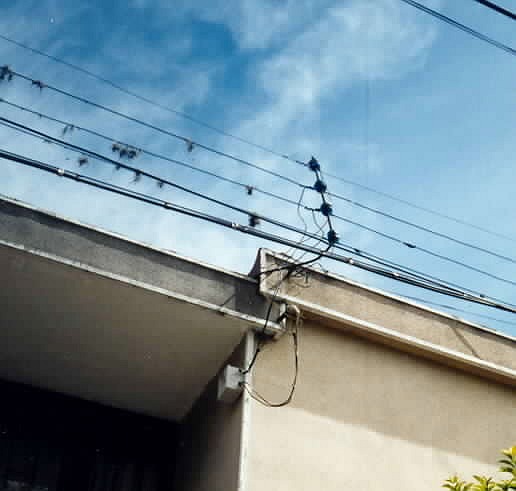
The main fascination I have for these glass jewels is the complete range of
colors they have been found in and, due to their small size, the relative ease
in displaying them. The first examples I located while living in the country in
1990-92 included Mint Green, Olive Green with Yellow Swirls, Foamy Amber
Blackglass, Deep Orange Amber, Deep Red Amber, Purple, Deep Lilac, Cranberry
Violet, Peacock Blue and Cobalt, Clear, Gray, Ice Aqua, Light Lavender, Royal
Purple, Magenta Blackglass and Milky Peacock Blue!
I was very fortunate to have recovered some of these spools because many of
them are truly scarce. For example, on one of my first hunts in the "wild
streets" of Bogota for spools was the amazing discovery of a rack of 3
green spools on the side of a building in the north side of town! With the help
of a local utility crew who changed them out for some readily available modern
spools, my contact recovered the Green with Yellow swirls, and two Mint Greens.
Initially this gave me the false impression they were readily available yet in two years of traveling and searching (with the assistance of several
scouts) I only saw one other Green spool on the side of a building in another
large industrial city many miles away. A contact of mine was able to hand
deliver it to me a few days before I left the country in 1992. I saw a mustard
spool in a catalog auction that came out of the Jim Overstreet collection a few
years later, and only this year was able to add a similar color spool to my
collection! (page 29, upper right) I can only confirm these two examples of the
mustard beauty, and it isn't listed in the Glass Insulators From Outside North
America (GIFONA) but will be published in the new World Wide Glass Insulators
Handbook that I am working on which will serve as a supplement to GIFONA.
Other previously reported CD 1050 spools which are considered rare and
underrated are any Ambers, Magenta Blackglass, Deep Violet, Deep Blue Lavender,
Mustard Yellow, Milky Yellow Olive, Milky Peacock Blue, Gray, and the true
Cobalt which is much deeper than the relatively common but still very beautiful
Peacock Blue. I also consider Aqua spools as scarce, with about 6-7 known. The
tough ones are the richer aqua shade, not the icy color which is a common color
for Zicme glass. I keep wondering if there is a CD 106 or 154 Amber Zicme
waiting to be discovered because the amber spools (like all other insulators)
were handmade from cullet rich recycled glass batches! In fact, I was able to
recover approximately 12 Teal Aqua CD 106's with varying amounts of red cullet
swirls inside and 2-3 crude CD 106 Teal Aquas with small milky cullet droplets
inside. Perhaps this helps explain the origins of Deep Red Amber spools. Since
most of the Red swirled CD 106's were found cracked it's possible the cullet
combination was incompatible with the glass batch, thus ending the use of amber
in their glass batches. Further evidence to support this is the scarcity of
amber spools and non-existence of other Zicme insulators with amber swirls in
them. I've found Zicme insulators with cullet based swirls in Light Cobalt Blue,
Sage Green, Purple, Burgundy, Milk, Yellow, Red, Smoke and possibly others! Why
are all these colors found swirling inside insulators, yet I am unaware of a
single Zicme with amber swirls? Apparently the heavier cullet used in the glass
batches drifted to the bottom of the pot and evidently didn't get stirred or
mixed well because many insulators can be found with a wide variety of colors
swirling inside.
Over the last couple of years some fantastic new, unlisted color spools have
been discovered (many are one of a kind colors) including a Clear with Burgundy
swirls, Peacock Blue Jade Milk, Mustard with Citrine swirls, Milky Yellow Olive,
Pink, Lilac Lavender, Burgundy with Cobalt swirls, Lemon tint, and Cornflower
Blue!
Another source of interesting spools can be found in Australia. There are
several new spools that have been found in recent years in Australia, but
unfortunately I have not been able to obtain an example for my collection. You
may view a photo of the CD 1058 in Light Amethyst and Straw online at http://www.insulators.com/pictures/?id=6640018.
My favorite glass spool from Australia currently in my collection is a CD 1055
embossed A.G.M. L.T.O.!I that was found in an unlisted and attractive pale Olive
Green. The measurements vary slightly from the GIFONA, but it's close enough to
classify it as a CD 1055. (see photo page 29, top left)
One of the more colorful spools to be found in France includes this CD 1066
Sediver A22 (braille dots on base) in a fabulous Yellow Olive Green (bottom
right, page 27). It is slightly different than the other spools in this CD
assignment in that it has a different profile inside the wire groove area
perhaps modified from previous models to reinforce the insulator to handle
heavier cables and wires, and/or to increase the leakage distance between the
wire and the pin.
A couple of recently discovered spools come from Belgium. This cute little
fella is barely wider than a quarter, measuring a meager 1 inch across base, by
3/4 inch tall!! It has an unusual cross top grooves suggesting it may have had
been used to secure wires on it. It's embossed "B TE S.G.D.G." on
front skirt and No.1 on reverse skirt. (color photo at bottom right, page 29)
The embossing suggests there are other style numbers made by this previously
unknown manufacturer. Although the name could be the company that supplied them
or it could indicate the user of the product. It's still a mystery and I invite
our readers to contact me if they obtain further information. One additional
interesting thing about this insulator is that on the base of the insulator are
mold lines that curve under the base but are interrupted by what looks like
excess glass that was either trimmed or snapped off at the factory. This could
indicate they were hand blown in a mold. But since they are of such high quality
glass they are more likely of much newer technology. No further information is known
about the spool at this time.

I also purchased a cute white porcelain knob from Belgium hoping it was
nearly identical to a green aqua CD 1096 I purchased from a seller in France.
(page 29 bottom, middle) Upon closer examination I discovered the porcelain knob
is clearly smaller in size, unembossed and has external circular ribs around the
lower skirt. For some reason it reminded me of CD 553.2 and CD 563.1 insulators
made by Folembray which have external ribs around the skirt, albeit not as
dramatic. It's just an unusual coincidence and an interesting find as its
unlikely that there is any connection between the small porcelain knob and the
much larger glass insulators with ribs.
Look for more exciting discoveries from around the world in upcoming Crown
Jewels. I have some fantastic discoveries I will be reporting about from
Scotland, England, Australia, Italy, Chile, and Argentina. If you would like to
report new discoveries or if you have a question regarding a particular
insulator or manufacturer, please write to me directly at my new address:
Caleb Thimell
5101 Linbar Drive
Apt H216
Nashville, TN 37211
(615) 781-3830
zicme_insulators@hotmail.com
I'm usually at home M-F from 3:30 pm till 9:00 pm CST
or 9 am - 9 pm on
Saturdays.
Please limit calls to between these hours.
Foreign Insulator Spools
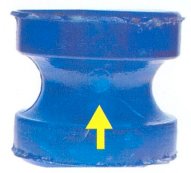
Embossing mark
|
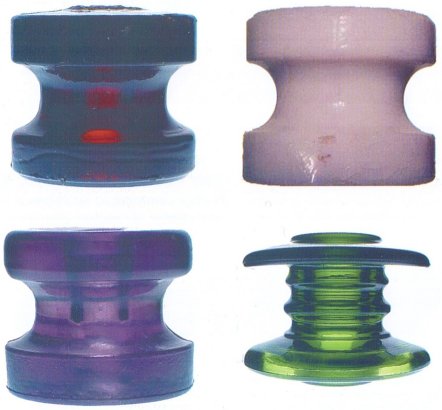
|
|
SEDIVER A 22 |
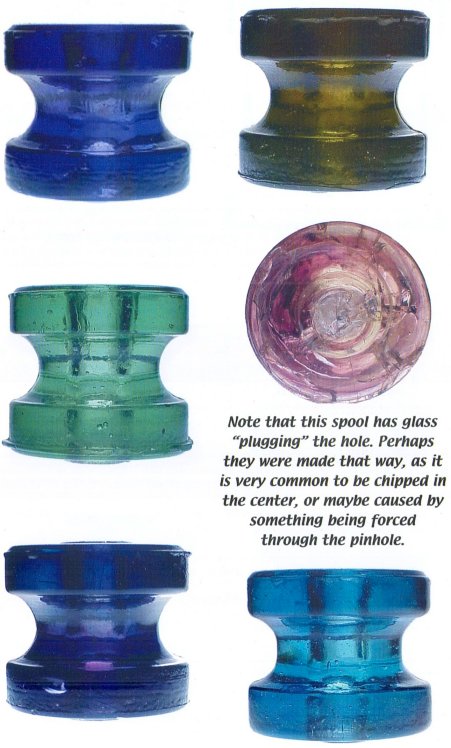
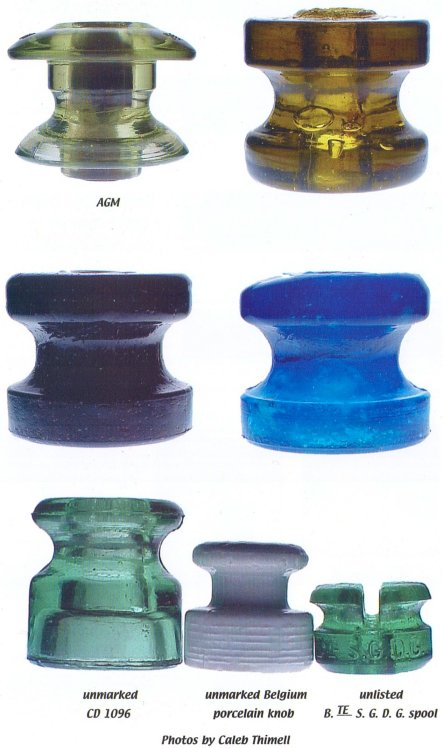
|
